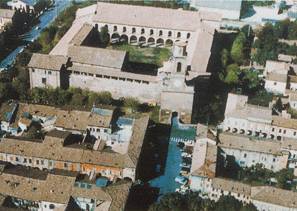 The territory of Novellara is situated in the part of the Po River Valley known as the "Lowlands of Reggio Emilia", a few kilometres from the river Po.
The territory of Novellara is situated in the part of the Po River Valley known as the "Lowlands of Reggio Emilia", a few kilometres from the river Po.
- Antique market on the first Sunday of each month
- The Fair of San Cassiano (4 May)
- Postal code: 42017 Area code: 0522
- Open-air market every Thursday
Inhabitants:
13,548 update Jannuary, 1 2009 |
How to get there:
From the Reggio Emilia exit on the A1 motor-way, take National Road SS 12 travelling north. Travelling on National Road SS 9, when you reach Reggio Emilia take National Road SS 12, which leads from the northern ring road to the A1 motor-way and on to Bagnolo and Novellara. Novellara is located immediately after Bagnolo. When coming from Mantua on the A22 motor-way, which runs between Modena and Brennero, exit at Reggiolo/Rolo. From the town of Reggiolo, which is only a few kilometres away, take National Road SS 12 travelling south. You can also take National Road SS 63 from Mantua to Guastalla, and turn left at Guastalla to travel southeast, arriving directly in Novellara. The muncipalities which border on Novellara are Bagnolo in Piano, Cadelbosco Sopra, Campagnola Emilia, Guastalla, and Reggiolo. Novellara Railway Station |
Tourist information:
Town Hall 0522 655454 Fax 0522 652057 |
It is likely that the early name of this town before it became "Novellara" was "Nubilaria" or "Nuvelaria", in reference to the fog and clouds that frequently waft into the area from the wetlands. In 1100, a Lombardic noble by the name of Gherardaccio Malapresa turned the village into a fortified town by building a strong watchtower on the highest spot to defend the area. About 200 years later, Feltrino Gonzaga of the famous Gonzaga family of Mantua became lord of Reggio Emilia. Threatened by the military might of Marquis Nicol˛ d'Este, the Manfredi family, and Count Lucio of Lando, Feltrino was forced to sell Reggio Emilia to Bernab˛ Visconti, keeping Bagnolo and Novellara for his own family. Thus a minuscule fief was created which, when raised to the status of county, was wisely governed by the Gonzaga family until 1728, the year of the death of the last Count of Gonzaga, Filippo Alfonso. The early part of the Gonzaga seignory was not a tranquil period, since bitter hatred separated the Gonzagas of Novellara from their cousins in Mantua. In order to create a strong shelter against their enemies, the Gonzagas began construction on the Novellara Fortress under the direction of Guido. He also ordered plans drawn up for the construction of a new village, to be built to the west of the fortress along straight lines and including the fascinating porticoes that still charcterise Novellara today. Land reclamation projects were begun, and gradually contributed to the elimination of diseases caused by stagnant, infested waters. New roads, fine churches, and sumptuous little country villas were built, and a standard of living that attracted new inhabitants was created. People were also attracted to the town by what could be considered a good, wise government for the times. After the death of the last member of the Gonzaga family of Novellara, Filippo Alfonso, the fief was confiscated and later given to the Duke of Modena by the emperor. Today Novellara preserves many memories of its past. Unfortunately, many buildings, convents, and churches have been damaged, but in spite of this, it is not difficult to find signs of the town's past dignity in the old streets with their low, silent porticoes. The Collegiate Church of San Stefano is a prized work of architecture by Lelio Orsi. The Novellara Fortress still preserves medieval and Renaissance structures in its walls and its corner towers with and . A collection of pharmaceutical ceramic jars of rare beauty is left from the old Jesuit pharmacy. The Gonzaga family archives are of exceptional interest, and the Gonzaga Museum will become an absolute must for visitors to the interior of the fortress.